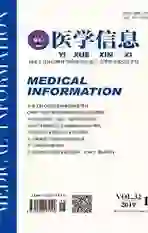肝型脂肪酸结合蛋白在糖尿病中的研究
2019-10-21王静郭宏敏
王静 郭宏敏
摘要:肝型脂肪酸结合蛋白(L-FABP)在肝脏、肾脏等组织细胞中表达。有研究表明,L-FABP与糖尿病的发生、发展密切相关。同时作为肾损伤的敏感指标,尿L-FABP成为糖尿病肾病早期诊断的标志物之一并能预测病情的转归。本文就肝型脂肪酸结合蛋白在糖尿病中的研究进展进行综述。
关键词:肝型脂肪酸结合蛋白;糖尿病;糖尿病肾病
中图分类号:R587.1 文献标识码:A DOI:10.3969/j.issn.1006-1959.2019.18.007
文章编号:1006-1959(2019)18-0018-03
Abstract:Hepatic fatty acid binding protein (L-FABP) is expressed in tissue cells such as liver and kidney. Studies have shown that L-FABP is closely related to the occurrence and development of diabetes. At the same time, as a sensitive indicator of kidney injury, urinary L-FABP becomes one of the early markers of diabetic nephropathy and can predict the outcome of the disease. This article reviews the research progress of hepatic fatty acid binding protein in diabetes.
Key words:Hepatic fatty acid binding protein;Diabetes;Diabetic nephropathy
肝型脂肪酸结合蛋白(liver-type fatty acid binding protein,L-FABP,FABP1)属于脂肪酸结合蛋白(fatty acid binding protein,FABP)家族的成员之一,分子量14 kDa,是一种可以结合长链脂肪酸的蛋白。FABP家族发现于1972年,目前已经有4个亚家族9种不同亚型。L-FABP主要表达在肝脏,其余少量表达在肠、胰腺、胃、肺及肾脏,其中只在人类肾脏的近曲小管中表达而啮齿类动物不表达。近几年的研究表明,L-FABP与肿瘤、脂肪肝、肾脏疾病、肥胖症、糖尿病等多种疾病密切相关,本文就L-FABP在糖尿病中的研究进展作一综述。
1 L-FABP 的结构
L-FABP基因定位在2号染色体,总共编码127种氨基酸,每个L-FABP均含有2个脂肪酸的结合位点[1]。同其他类型的FABP空间结构相似,L-FABP的结构是围绕疏水核心形成的一个β折叠桶,由10个反向平行的β链构成,其N-端连接2个短的α-螺旋结构。其他的FABP只能结合一个脂肪酸分子,而L-FABP入口处具有的独特结构特点使其β折叠桶的稳定性较强,空间构型不易改变,因此可以结合2个脂肪酸分子[2]。
2 L-FABP的生理功能
2.1参与脂肪酸代谢 L-FABP在长链脂肪酸(long chain fatty acids,LCFAs)代谢中起关键作用,它在细胞膜表面结合脂肪酸并将脂肪酸转运至胞浆内线粒体,通过β氧化直接代谢脂肪酸,向肾小管上皮细胞供能。同时通过转运脂肪酸至细胞核内,启动过氧化物酶体介导的氧化代谢,将脂肪酸降解[3,4]。
2.2参与细胞信号转导 L-FABP可以作为细胞内信号传递通路上的一个组成部分。L-FABP的启动子区域,包含了过氧化物酶增殖体激动受体α(peroxisome proliferation activated receptor-α,PPAR-α)的一个反应元件。L-FABP发送信号因子至胞内,激活PPAR-α。反之,PPAR-α的激活可上调L-FABP水平,PPAR-α的活性与细胞内 L-FABP的浓度呈正相关[5]。
2.3抗氧化作用 在出现超负荷的脂肪酸、缺血缺氧、寒冷刺激等状态时,肾脏出现氧化应激反应,产生大量活性氧簇(reactive oxygen species,ROS),介導脂质氧化过程,造成肾脏损害。L-FABP可以高效结合过量的脂肪酸和脂质氧化产物,将其氧化还原并转运至肾小管排泄,从而保护肾小管及肾小球损害[6]。
2.4介导炎症反应 一项体外细胞实验中提取L-FABP的cDNA,并将其重组表达在大肠杆菌中,与不同类型的细胞共同培养,发现均可降低IL-6的浓度,提示可能介导炎症反应[7]。
3 L-FABP在糖尿病中的意义
3.1参与糖脂代谢 作为游离脂肪酸(FFA)的载体,L-FABP主要参与脂质代谢,在形成脂肪肝、肥胖中起到重要作用,包括影响2型糖尿病的发生,均是以其在脂代谢中的作用为中心的。L-FABP可以结合乙酰辅酶A羧化酶抑制剂(TOFA),通过影响PPARα来抑制脂肪合成,而且与葡萄糖水平正相关,在正常葡萄糖水平下,并无抑制作用[8]。因此,L-FABP有望成为脂肪肝、肥胖、糖尿病等疾病的药物治疗靶点。
3.2預测糖尿病肾病的发生及进展 正常生理状态下,L-FABP主要在肝脏合成,释放入血循环,经肾小球滤过,被重吸收入肾小管,极少量可在尿液中检测到。在肾小管氧化应激或缺血情况下,L-FABP在肾脏的表达增加,对抗氧化应激,保护肾脏[9],同时研究发现尿L-FABP在肾脏损伤后含量增加,不受血L-FABP含量的影响,是一种急性及慢性肾脏病的早期肾损害标志物[10-12]。在糖尿病患者中,L-FABP的研究也主要集中在糖尿病肾病方面。
3.2.1预测糖尿病肾病的发生 多项研究证实无论是在1型糖尿病还是2型糖尿病患者中,在尿微量白蛋白正常人群中,尿L-FABP水平已经较健康人群升高,原因不明,在进展为微量白蛋白尿及大量白蛋白尿的患者中尿L-FABP表达更高。这提示糖尿病患者在正常尿微量白蛋白时期可能就存在肾小管损害,可作为一个预测更早期肾损害的标志物[13]。
3.2.2判断糖尿病肾病的发展 相较于其他肾损害标志物,如中性粒细胞明胶酶相关脂质运载蛋白(NGAL)、肾损伤因子-1(KIM-1)等,L-FABP可能是更有前景的生物学标志物,因为它不仅更早提示肾损害,而且可以判断预后。黄志勇等[14]对133例糖尿病患者进行研究,发现尿液L-FABP的水平与糖尿病肾病的严重性相关,尿L-FABP水平随着正常、微量白蛋白尿、大量白蛋白尿的进展而升高。另一项对2型糖尿病患者14年的长期随访观察[15]也提示,在高水平尿L-FABP组的患者中,肾功能恶化及终末期肾脏病的发生率增加,高水平的尿L-FABP可以预测糖尿病肾病患者蛋白尿及终末期肾病的发生。在1型糖尿病患者中也观察到相似的结果[16]。近期的研究中,研究对象更是扩展到妊娠糖尿病[17]、儿童起病的1型糖尿病[18]。因此,尿L-FABP不仅能够反映糖尿病肾病的严重程度,且高水平尿L-FABP可做为糖尿病肾病进展的危险因素,被认为是一个独立的糖尿病肾病的预测因子,预测灵敏度在90%[16]。然而也有不同意见,认为该指标不能起到预测的作用[19]。在尿微量白蛋白正常的糖尿病人群中,尿L-FABP增高的原因并不清楚,其预测糖尿病肾病发生发展的水平划分也并无一致意见。
3.2.3临床影响因素分析 近期日本的一项临床观察提示在正常尿微量白蛋白的2型糖尿病患者中,尿L-FABP的水平与糖化血红蛋白、肾小球滤过率、收缩压相关。而在尿蛋白阳性的2型糖尿病患者中,使用血管紧张素受体抑制剂、尿蛋白/尿肌酐比值及高密度脂蛋白与尿L-FABP水平相关。在进行降血糖等治疗后,糖化血红蛋白的降低在两组人群中均与尿L-FABP水平成正相关[20]。然而也有研究认为尿L-FABP与糖化血红蛋白没有相关性[21],这有可能是和不同研究选择人群的疾病阶段不同以及观察时间有关。与尿微量白蛋白相比,尿L-FABP更容易在短期内受代谢、外界因素影响而变化。
3.2.4动物及体外细胞研究 动物实验发现转染L-FABP基因小鼠在糖尿病造模后,其肾小管上皮细胞高表达L-FABP,并且其肾脏的巨噬细胞及炎症因子的表达较野生型小鼠明显下降[22]。体外细胞实验发现脂肪酸可以上调肾小管上皮细胞中L-FABP的表达,但白蛋白没有相关影响。高糖及糖基化终末产物对肾小管上皮细胞表达L-FABP的影响并无相关研究。
3.3预测糖尿病大血管事件的发生 一项针对1型糖尿病患者的观察研究发现,高水平的尿L-FABP 是卒中及心血管死亡率的独立危险因素[23]。Maeda Y等[21]的研究也提示在2型糖尿病患者CKD G1及G2期,尿L-FABP的水平可以预测及评估心血管损害的程度。
3.4药物影响 吡格列酮可降低尿微量白蛋白期的2型糖尿病患者的尿L-FABP水平,而格列苯脲、伏格列波糖及那格列奈没有上述作用。降压药物替米沙坦[24]、奥美沙坦、赖诺普利及azelnidipine(一种钙离子拮抗剂)可降低糖尿病患者尿L-FABP水平[25,26]。近期有报道称阿格列汀、利格列汀[27、28]也有类似作用。另外,尚有一些中草药治疗可降低糖尿病患者尿L-FABP水平[29,30]。这提示可能尿L-FABP的降低并非直接来源于降糖,而更多的可能是其他途径,如氧化应激、炎症等。
总之,L-FABP在糖尿病患者的尿液标本中的含量可考虑作为一种预测早期肾脏损伤发生、DN预后甚至大血管病变的标志物,尤其在糖尿病肾病方面,其灵敏度较尿微量白蛋白更高,提示肾损害更为早期,加之样本获取较为方便及无创,值得临床应用。而其在糖脂代谢方面的作用以及对肾脏的保护作用可能会成为新的药物治疗靶点而进一步研究。
参考文献:
[1]Michael DS.Digestion and absorption of dietary triglycerides.In:Leung Po Sing,editor.The gastrointestinal system:gastrointestinal,nutritional and hepatobiliary physiology[M].New York:E-Publishing Inc,2014:160-178.
[2]Huang H,Mc Intosh AL,Martin GG,et al.Structural and functional interaction of fatty acids with human liver fatty acid binding protein(L-FABP)T94A variant[J].FEBS J,2014,281(9):2266-2283.
[3]Atshaves BP,Martin GG,Hostetler HA,et al.Liver fatty acid binding protein and obesity[J].J Nutr Biochem,2010,21(6):1015-1032.
[4]Martin GG,Atshaves BP,McIntosh AL,et al.Liver fatty acid-binding protein gene-ablated female mice exhibit increased age-dependent obesity[J].J Nutr,2008,138(10):1859-1865.
[5]Schachtrup C,Emmler T,Bleck B,et al.Functional analysis of peroxisome proliferator responsive element motifs in genes of fatty acid binding proteins[J].Biochem J,2004,382(Pt1):239-245.
[6]Chen XY,Li R,Geng ZY.Cold stress initiates the Nrf2/UGT1A1/L-FABP signaling pathway in chickens[J].Poult Sci,2015,94(11):2597-2603.
[7]Hyunwoo Kim,Gaae Gil,Siyoung Lee,et al.Cytokine-like Activity of Liver Type Fatty Acid Binding Protein(L-FABP)Inducing Inflammatory Cytokine Interleukin-6[J].Immune Netw,2016,16(5):296-304.
[8]Huang H,Mcintosh AL,Martin GG,et al.Inhibitors of Fatty Acid Synthesis Induce PPARα-Regulated Fatty Acid β-Oxidative Genes:Synergistic Roles of L-FABP and Glucose[J].PPAR Research,2013,2013(2013):865604.
[9]Ichikawa D,Kamijo-Ikemori A,Sugaya T,et al.Renal liver-type fatty acid binding protein attenuates angiotensin Ⅱ-induced renal injury[J].Hypertension,2012,60(4):973-980.
[10]Yang J,Choi HM,Seo MY,et al.Urine liver-type fatty acid-binding protein predicts graft outcome up to 2 years after kidney transplantation[J].Transplant Proc,2014,46(2):376-380.
[11]Parr SK,Clark AJ,Bian A,et al.Urinary L-FABP predicts poor outcomes in critically ill patients with early acute kidney injury[J].Kidney Int,2015,87(3):640-648.
[12]Belcher JM,Garcia-Tsao G,Sanyal AJ,et al.Urinary biomarkers and progression of AKI in patients with cirrhosis[J].Clin J Am Soc Nephrol,2014,9(11):1857-1867.
[13]Viswanathan V,Sivakumar S,Sekar V,et al.Clinical significance of urinary liver-type fatty acid binding protein at various stages of nephropathy[J].Indian J Nephrol,2015,25(5):269-273.
[14]黃志勇,王利,汪慧,等.糖尿病肾病患者尿L-FABP的检测及其临床意义[J].武汉大学学报,2015,36(2):266-269.
[15]Araki SI,Haneda M,Koya D,et al.Predictive effects of urinary liver-type fatty acid-binding protein for deteriorating renal function and incidence of cardiovascular disease in type 2 diabetic patients without advanced nephropathy[J].Diabetes Care,2013,36(5):1248-1253.
[16]Abd El Dayem S,El Bohy Ael M,El Shehaby A.Follow up of value of the intrarenal resistivity indices and different renal biomarkers for early identification of diabetic nephropathy in type 1 diabetic patients[J].J Pediatr Endocrinol Metab,2016,29(3):273-279.
[17]Fu WJ,Wang DJ,Deng RT,et al.Urinary liver-type fatty acid-binding protein Change in gestational diabetes mellitus[J].Diabetes Res Clin Pract,2015,109(3):e36-e38.
[18]Suh JS,Kim SH,Cho KS,et al.Urinary markers in the early stage of nephropathy in patients with childhood-onset type 1 diabetes[J].Pediatr Nephrol,2016,31(4):623-631.
[19]Chou KM,Lee CC,Chen CH,et al.Clinical value of NGAL,L-FABP and albuminuria in predicting GFR decline in type 2 diabetes mellitus patients[J].PLoS One,2013,8(1):e54863.
[20]Hiroyuki Ito,Hitomi Yamashita,Mina Nakashima,et al.Current metabolic status affects urinary liver-type fatty-acid binding protein in normoalbuminuric patients with type 2 diabetes[J].J Clin Med Res,2017,9(4):366-373.
[21]Maeda Y,Suzuki A,Ishii J,et al.Level of urinary liver-type fatty acid-binding protein is associated with cardiac markers and electrocardiographic abnormalities in type-2 diabetes with chronic kidney disease stage G1 and G2[J].Heart Vessels,2014,30(3):362-368.
[22]Atsuko Kamijo-Ikemori A,Sugaya T,Sekizuka A,et al.Amelioration of diabetic tubulointerstitial damage in liver-type fatty acid-binding protein transgenic mice[J].Nephrol Dial Transplant,2009,24(3):788-800.
[23]Panduru NM,Forsblom C,Saraheimo M.Urinary liver-type fatty acid binding protein is an independent predictor of stroke and mortality in individuals with type 1 Diabetes[J].Diabetologia,2017,60(9):1782-1790.
[24]Nakamura T,Fujiwara N,Sato E,et al.Renoprotective Effects of Various Angiotensin Ⅱ Receptor Blockers in Patients with Early-Stage Diabetic Nephropathy[J].Kidney Blood Press Res,2010,33(3):213-220.
[25]Abe M,Oikawa O,Okada K,et al.Urinary angiotensin-converting enzyme 2 increases in diabetic nephropathy by angiotensin Ⅱ type 1 receptor blocker olmesartan[J].J Renin Angiotensin Aldosterone Syst,2015,16(1):159-164.
[26]Abe M,Maruyama N,Okada K,et al.Additive antioxidative effects of azelnidipine on angiotensin receptor blocker olmesartan treatment for type 2 diabetic patients with albuminuria[J].Hypertens Res,2011,34(8):935-941.
[27]Kitada M,Tsuda SI,Konishi K,et al.Anagliptin ameliorates albuminuria and urinary liver-type fatty acid-binding protein excretion in patients with type 2 diabetes with nephropathy in a glucose-lowering-independent manner[J].BMJ Open Diabetes Res Care,2017,5(1):e000391.
[28]Makino H,Matsuo M,Hishida A,et al.Effect of linagliptin on oxidative stress markers in patients with type 2 diabetes:a pilot study[J].Diabetol Int,2018,10(2):148-152.
[29]Wang J,Guo HM.Astragaloside IV ameliorates high glucose-induced HK-2 cell apoptosis and oxidative stress by regulating the Nrf2/ARE signaling pathway[J].Exp Ther Med,2019,17(6):4409-4416.
[30]Yang X,Zhang B,Lu X,et al.Effects of Tangshen Formula on urinary and plasma liver-type fatty acid binding protein levels in patients with type 2 diabetic kidney disease:post-hoc findings from a multi-center,randomized,double-blind,placebo-controlled trial investigating the efficacy and safety of Tangshen Formula in patients with type 2 diabetic kidney disease[J].BMC Complementary and Alternative Medicine,2016(16):246.
收稿日期:2019-6-6;修回日期:2019-6-25
編辑/杨倩
